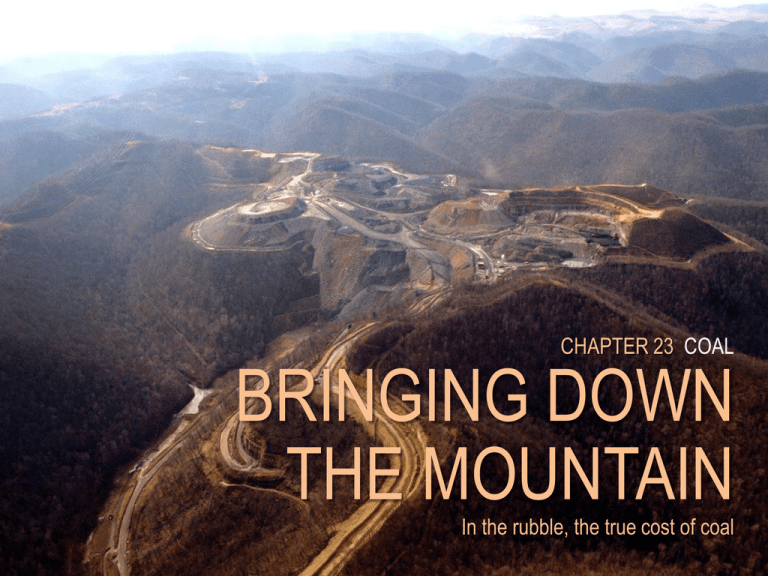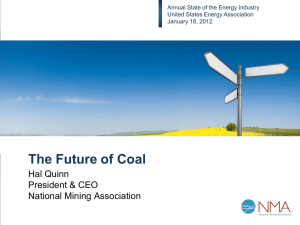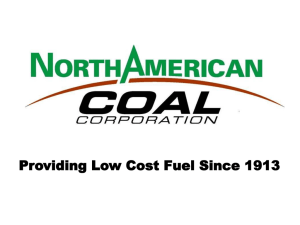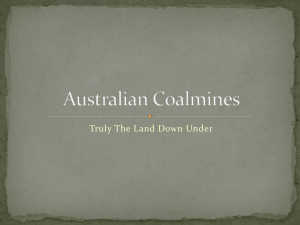saes1ext_lect_outline_ch23
advertisement

CHAPTER 23 COAL BRINGING DOWN THE MOUNTAIN In the rubble, the true cost of coal 23 BRINGING DOWN THE MOUNTAIN In the rubble, the true cost of coal Main Concept Coal plays a major role as an energy source around the world. Despite efforts to reduce the health and environmental risks associated with burning coal, the impact of mining operations will continue as long as we use coal. Spruce No. 1 mine West Virginia 23 BRINGING DOWN THE MOUNTAIN In the rubble, the true cost of coal Learning Outcomes At the end of this unit you should know: The importance of coal as a global energy source Methods associated with extracting coal and using it to generate electricity The role of technology in reducing negative impacts Spruce No. 1 mine West Virginia 23 BRINGING DOWN THE MOUNTAIN In the rubble, the true cost of coal Case Study: Coal mining in Appalachia Background: Surface mining for coal involves blasting off several hundred feet of mountaintop and dumping the rubble nearby before extracting the coal below. TERMS TO KNOW: Coal Mountaintop removal Energy Fossil fuels Electricity 23 BRINGING DOWN THE MOUNTAIN In the rubble, the true cost of coal Mining operations have claimed nearly a million acres of forested mountain, across four states—Kentucky, West Virginia, Virginia, and Tennessee. There is still more to come as the coal industry moves ahead supplying our primary energy source for electricity production. TERMS TO KNOW: Coal Mountaintop removal Energy Fossil fuels Electricity 23 Coal is an important fossil fuel energy source Energy – Capacity to do work Fossil fuels – Non-renewable carbon-based resources Heat and cool homes Operate cell phones Power lamps and laptops Fuel our cars Power our industry 1 pound of coal = electricity for ten 100-watt bulbs for an hour or an energy-efficient refigerator for 20 hours The United States uses about 1 billion tons of coal per year. A U.S. family of four uses about 9000 lbs per year. 40% of electricity worldwide and 45% in the United States comes from coal. Energy Return on Energy Investment (EROEI): Coal 8:1, oil 15:1, nuclear 6:1, and wind 20:1 1,000,000,000 x 2000 23 Coal is an important fossil fuel energy source The most common way to generate electricity is by heating water to produce steam. 1 pound of coal = electricity for ten 100-watt bulbs for an hour 23 Coal is an important fossil fuel energy source The most common way to generate electricity is by heating water to produce steam. 1 pound of coal = electricity for ten 100-watt bulbs for an hour 23 Coal is an important fossil fuel energy source The most common way to generate electricity is by heating water to produce steam. 1 pound of coal = electricity for ten 100-watt bulbs for an hour 23 Coal is an important fossil fuel energy source The most common way to generate electricity is by heating water to produce steam. 1 pound of coal = electricity for ten 100-watt bulbs for an hour 23 Coal is an important fossil fuel energy source The most common way to generate electricity is by heating water to produce steam. 1 pound of coal = electricity for ten 100-wat 23 Coal is an important fossil fuel energy source Coal has shaped waves of progress from the United Kingdom to the United States and now into China. Economies have increased, but so have health impacts through the use of coal. Black lung, birth defects, etc. Coal is the main fossil fuel source used to produce electricity, but its role is slowly being reduced as use of renewable fuels increases. 23 Coal forms over millions of years TERMS TO KNOW: Energy return on energy investment (EROEI) Formation of the Appalachian Mountains was the last and greatest of the events that joined all of the world’s land into one super-continent a few million years before the dinosaurs. 23 Coal forms over millions of years TERMS TO KNOW: Energy return on energy investment (EROEI) Coal is formed over long periods of time as plant matter is buried in an oxygen-poor environment and subjected to high heat and pressure. Today, these areas are called coal reserves. 23 Coal forms over millions of years TERMS TO KNOW: Energy return on energy investment (EROEI) Coal is formed over long periods of time as plant matter is buried in an oxygen-poor environment and subjected to high heat and pressure. Today, these areas are called coal reserves. 23 Coal forms over millions of years TERMS TO KNOW: Energy return on energy investment (EROEI) Coal is formed over long periods of time as plant matter is buried in an oxygen-poor environment and subjected to high heat and pressure. Today, these areas are called coal reserves. 23 One ton of extracted coal leaves seven tons of overburden. TERMS TO KNOW: Energy return on energy investment (EROEI) Overburden Coal forms over millions of years 23 Coal forms over millions of years Tectonic upheaval, deep and rapid burying of organic material, and slow compaction into coal has been repeated around the globe. Europe holds about 36% of the world’s reserves, another 30% in Asia, and a little more than 28% in North America. Coal recovery in the Appalachian beds was easy 150 years ago, but now, extraction methods have become more destructive, as minable coal becomes harder to reach. Hobet 21 has claimed at least 12,000 acres of land. Clear-cutting, drilling, and blasting have left some 80 million tons of overburden each year. 23 Mining comes with a set of serious trade-offs TERMS TO KNOW: Surface mining Subsurface mines Acid mine drainage Mountaintop removal After clear-cutting forests, drilling into the sides of the mountains, and blasting what remained…. The process was repeated until the neighboring valleys were filled with overburden and the forest habitat was obliterated and streams were buried. 23 Mining comes with a set of serious trade-offs TERMS TO KNOW: Surface mining Subsurface mines Acid mine drainage Surface mining After clear-cutting forests, drilling into the sides of the mountains, and blasting what remained…. The process was repeated until the neighboring valleys were filled with overburden and the forest habitat was obliterated and streams were buried. 23 Mining comes with a set of serious trade-offs Surface mining - In strip mining, overburden is set aside and used to refill the pit left by mining the coal before moving on to the next strip. Subsurface mining – Methane is released, acidifying water, toxins leach from surrounding rocks, sulfates produce acid drainage; it affects everything from nutrient cycles to the entirety of the local food web. Up side: less alteration to large surface areas and more jobs. 23 Mining comes with a set of serious trade-offs COAL DUST – Black lung disease from breathing coal dust. In 2004, there were 703 coal miner deaths from pneumoconiosis compared to 26 from accidental death. EXPLOSIONS AND MINE COLLAPSE – Methane gas and coal dust are major causes of explosions. 362 miners died in the worst mining explosion in U.S. history (1907) and 29 in a single accident in 2010. FIRE – Some have been burning for hundreds of years! A mine fire in Pennsylvania has been burning since 1962 and caused the town to be abandoned. TOXIC FUMES – In 2006, twelve miners died from carbon dioxide poisoning while trapped in West Virginia. 23 Surface mining brings severe environmental impacts TERMS TO KNOW: Environmental impact statement Maria Gunnoe – Goldman Environmental Prize winner 23 Surface mining brings severe environmental impacts Over time, mining has led to “No Trespassing” signs, blasting, millions of tons of overburden, loss of forests, soil compaction, and more frequent and severe flooding. The ground can’t absorb water and surrounding valleys are filled with overburden. Flooding in 2003 nearly swallowed up the town of Bob White including houses, barns, and families. Toxins fill the air and children in the area have a higher incidence of birth defects including heart, lung, and central nervous system disorders associated with the fumes from blasting. Mining is linked to bioaccumulation and biomagnification of toxins worldwide. 23 Surface mining brings severe environmental impacts Loss of biodiversity in aquatic systems affects forest life and impacts the very base of the food web. Increases in nitrogen and phosphorus availability: - Altered aquatic systems - Eutrophication - Increases in sulfatefeeding bacteria - Production of toxic hydrogen sulfide Environmental Impact Statement (EIS) – Positive and negative impacts of any action potentially causing environmental damage. Dangers to the environment are similar to those experienced around the world. Mining operations beyond coal include gold, copper, iron ore, and other geological resources. 23 Surface mining brings severe environmental impacts Mining impacts Toxic ash, sulfates , mercury, arsenic, lung disease, nitrogen oxides, CO2, kidney disease, loss of habitat, toxic selenium, compacted soil, increased flooding, thermal pollution Clean-up potential? 23 Surface mining brings severe environmental impacts Mining impacts 23 Can coal’s emissions be cleaned up? Clean-up potential? 23 Can coal’s emissions be cleaned up? Coal-burning pollutes the environment by releasing a wide range of toxins—sulfur, carbon monoxide, nitrogen oxide, carbon dioxide, radioactive materials, and particulate matter. At the end of 2011, the EPA imposed Mercury and Air Toxic standards that will reduce emissions by 90% and predicted to save $90 billion in human health over the first 5 years. TERMS TO KNOW: Carbon capture and sequestration (CCS) 23 Can coal’s emissions be cleaned up? Coal-fired plants generate tons of toxic fly ash—most is buried in landfills or stored in open ponds. 2008 – TVA Kingston Fossil Plant in Tennessee – Holding pond failed and released 1.1 billion gallons of fly ash into nearby rivers. Clean-up estimates are $1.2 billion. $1,200,000,000 TERMS TO KNOW: before the costs of property damage and lawsuits are added in. Carbon capture and sequestration (CCS) 23 Can coal’s emissions be cleaned up? Externalized (health, environmental, and property) costs for mining and using coal are between $300-500 billion per year— more than twice what consumers actually pay. Potential solution Clean Coal Technology Reduce the amount of pollution produced by coal by capturing TERMS TO KNOW: particulate matter, Carbon capture sulfur, and CO2. Still doesn’t eliminate and sequestration all toxic by-products or (CCS) stop mining. 23 Carbon Capture and Sequestration (CCS) CO2 is released when coal burns and is trapped by a solvent before it leaves the smokestack. Can coal’s emissions be cleaned up? 23 Carbon Capture and Sequestration (CCS) CO2 is released when coal burns and is trapped by a solvent before it leaves the smokestack. A stripper separates CO2 from the solvent and repurposes it for industry. Can coal’s emissions be cleaned up? 23 Carbon Capture and Sequestration (CCS) CO2 is released when coal burns and is trapped by a solvent before it leaves the smokestack. A stripper separates CO2 from the solvent and repurposes it for industry. Additional CO2 is injected deep underground into available wells, seams, and salt formations for longterm storage. Can coal’s emissions be cleaned up? 23 Reclaiming closed mining sites helps repair the area but does not restore the original ecosystem TERMS TO KNOW: Reclamation Before mining operation The controversial process of reclamation requires that the mined area be returned to a state close to premining conditions. After reclamation 23 Reclaiming closed mining sites helps repair the area but does not restore the original ecosystem Reclamation often involves use of alkaline materials to neutralize acids in the soil, priority for easily planted vegetation like grass rather than native species, and non-native loblolly pine to replace missing temperate forests. Before mining operation After reclamation 23 Reclaiming closed mining sites helps repair the area but does not restore the original ecosystem A valley in West Virginia after mining shows none of the original forest, ridges, or streams that were once found there. 23 Appalachian Regional Reforestation Initiative - arri.osmre.gov Upcoming events - beyondcoal.org PERSONAL CHOICES THAT HELP 23 UNDERSTANDING THE ISSUE 23 ANALYZING THE SCIENCE 23 Photo essay and another case study about mountaintop removal http://is.gd/ELKPBA http://is.gd/NQMsJH EVALUATING NEW INFORMATION 23 MAKING CONNECTIONS







